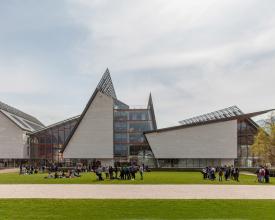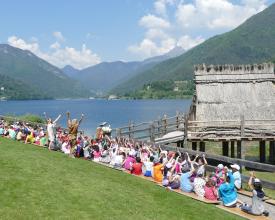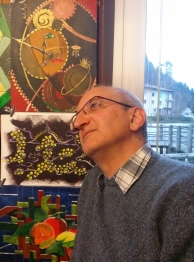
Museums and local development: connecting nature and culture at the Pile Dwelling Museum of Ledro and its connected networks

The solution looks at the long-standing experience of the Pile Dwelling Museum of Ledro and its work in establishing virtuous networks of museums, private and public stakeholders, and communities. The museum is in charge of promoting and interpreting the pile dwelling site of Lake Ledro, part of the 111 sites of the World Heritage site of the Prehistoric Pile Dwellings around the Alps.
The museum has an increasingly important role in the life of the Ledro Valley and its communities: it became the heart of a valley-wide multidisciplinary museum network which is active in the economic life of the valley, it contributed in raising awareness on the natural and cultural characteristics of the territory, and it contributes to strengthening the network between museums, public administration, private sector (including tourism) and local communities.
The inclusion in the framework of MUSE has offered the museum the chance to enhance its capacities and the presence of the museum in the Valley.
Context
Challenges addressed
- Environmental challenges: need to enhance and raise awareness on the local environment and territory of the Ledro Valley.
- Cultural and social challenges: lack of opportunities for local economic development; lack of knowledge and understanding of local heritage and cultural assets in the Ledro Valley; lack of interpretation and opportunities to get to know local heritage and to participate in its management.
- Economic challenges: lack of employment in the cultural sector; lack of income opportunities in the area.
Location
Process
Summary of the process
The solution looks at the work done by the Pile Dwelling Museum of Ledro in the development of and participation in active and dynamic networks of museums and institutions that over the years have supported the development of the Ledro Valley and its communities. From the ReLED museum network which has become the beating heart of the cultural and touristic offer of the Ledro Valley, to the connection and participation in the lively regional and global networks of the the MUSE.
The museum plays a central role in building capacities and offering on the field and in class multidisciplinary learning experiences which aim not only at the transmission of knowledge but also at putting children and participants in contact with their surrounding natural and cultural environment and its multiple components and interactions.
The creation of synergies and networks has empowered the museum to become an active member of the Ledro Valley and its communities.
Building Blocks
ReLED - Ledro Museum Network
The ReLED Museum Network was created in 2012 through a cooperation between the Municipality of Ledro the Science Museum of Trento and its territorial branch, the Pile Dwelling Museum of Ledro. This is not a new structure but a network of what was already present in the area, it is an innovative "way of working" that directly involves the Ledro Tourism Agengy and indirectly involves schools, cultural associations and tourism facilities in the area.
The network makes use of territorial management instruments such as the Network of Reserves of the Ledrensi Alps and the Biosphere Reserve of the “Alpi Ledrensi and Judicaria”, which is part of the UNESCO MaB designation.
ReLED involves over 70,000 people every year in workshops, guided tours, cultural entertainment activities that allow you to tell the Ledro valley through different disciplines: archeology, history, ethnography, natural sciences, geography and landscape. The Pale Dwelling Museum is the heart of these activities with over 40,000 visitors a year.
ReLED is today a small cultural company that actively involves (including caretakers, operators, officials, cleaning staff) over 20 people in an area that has 5500 inhabitants and id located 50km away from the regional city capital of Trento.
Enabling factors
Ledro is in in many ways a frontier. The valley it is located on the border between the Province of Trento and the region of Lombardy. This was an advantageous situation for ReLED because it allowed the freedom to develop lateral thinking, capable of going beyond the narrow limits of the museum's archaeological discipline which has been able of transforming a marginal place into a “center of the world”. ReLED was born with a key vision focused on engaging and promote multiple professionals and work experiences.
Lesson learned
A group works better than a single A close-knit group should be stable but also open to its members. It is important to ensure that activity that are carried out as part of existing jobs and not be based on voluntary acts.
At the basis of everything there is the passion that people have for these themes, which sustains the museum not only as a place of work but also as a means for mutual growth and a place of personal satisfaction.
Networking is not easy and requires a lot of effort, it requires taking one step back in order to be able to take two steps forward together.
We are aware that only a small part of museum visitors are specialists in the subject (4-5%) and therefore we need to be able to address a wider audience with specific and appropriate language.
ReLED is 40% self-financed. It actively contributes tolocal economy as an economic and cultural organization that has been able to think in economic terms without giving up content. There is the need understand development beyond infrastructures.
Culture is key to the Italian economy and ReLED has decided to invest in this by strengthening its human capital.
MUSE and its territorial network of museums
The Science Museum of Trento, MUSE, opened in 2013 in a requalified industrial area of the city of Trento. The museum, designed by Renzo Piano follows the principles of eco-sustainability and covers 12.600m2 divided into six floors and a tropical greenhouse. The museum and its architecture display the global variety of terrestrial habitats from mountaintops to sea-level, represented by the African tropical forests and the most relevant dinosaurs exhibition of the Alps.
The visitor engages with and understands the consequences of climate change and is exposed to science and technological information in a clear and simple manner, through captions, audiovisual material and visual effects. It is a museum that wants to make a difference and be an active player in the development of its community; the organization has moved from research-, education-, and communication-based activities towards new ways of connecting the museum’s agenda with local and international sustainable development goals with and for communities, policy- and decision-makers, as well as public and private economic actors.
MUSE is the heart of a lively territorial network of museums and visitor centers, including the Pile Dwelling Museum of Ledro, that are dealing with multiple disciplines as well as local and global dynamics.
Enabling factors
The ability to ask questions can be a synthetic way to define research, the educational process and, in general, culture. By focusing on the question and not the answer, MUSE was able to question itself and interact with the public. The museum has opened itself to a new urban design of the city in which it is inserted; involving the inhabitants of the territory and interacting with strong and recognized players in the local economy. It managed to build its own museological and museographic project by engaging in a dialogue with the city.
Lesson learned
Alongside the "classic" activities of exhibiting, presenting, educating, the current trends see museums practicing new ways of operating that connect them with the development dynamics of local communities, decision makers and businesses.
The relationship with the territory and the private sector is not restricted to the notion of "sponsorship", as it is generally understood. We focused on creating relationships of mutual interest: companies seek to grow their values, fostering development, innovation, employment, and territorial branding, which are all elements that are well practiced in a museum. This relationship has generated new languages and new relationships which have been translated into exhibition spaces, events and in other collaborations.
The educational and lab activities, the style of interpretation and mediation used for the various initiatives, and more general museum's ways of communicating have been often integrated as part of corporate mentoring, coaching and empowerment.
Companies have create and co-create cultural proposals with the museum, applying corporate themes that are functional to the museum.
Resources
Learning activities with local schools
The Ledro Museum Network (ReLED) has as its main point of action in the Pile Dwelling Museum of Lake Ledro. The museum employees, in over 20 years of experience, have refined methods of involvement, communication techniques and types of activities to be able to reach as many audiences as possible. In 2000, the first working group was gradually created which still continues its activity in the museum and constitutes the "historical memory of the institution that includes an archive of experiences, trainings and reference point for those who joined the museum and the network in following years.
At that time, the museum’s built what can be considered an industrial chair of work: in order to meet the demand it was necessary to create "working standards" both terms of activities with the public and schools and in the logistics, procurement of equipment and teaching materials as well as the precise distribution of the groups in rooms. The activities aimed at schools have found great support over the years, thanks to various innovations: new public facilities and a new museum have been created, the prehistoric village has been reconstructed, cooperation and management of other museums of the ReLED network and a continuous relationship with MUSE
Enabling factors
Over the years the museum has hired staff: 9 assistants were designated between '11 and '14. This positively fed the work environment. Between '19/'20, the definition of permanent contracts indicated the maturation of the working group. Additionally, the museum is recognized as a contributing institution by the local municipal administration, which acknowledged the importance of the role and constant dialogue with between the museum and local schools in Ledro. The MoU bertween the insitutions is based on enhancing the knowledge of local environments.
Lesson learned
- The close contact with the school environment has allowed ReLed to develop efficient and effective tools. The constant interaction with the school system in Ledro and the Basso Sarca, which began in 1990s, had led to a joint MoU focused on activities dedicated to children and pupils in elementary and middle schools. Each school year is given a specific theme to explore in connection to the Ledro territory and environment.
- The work focuses on the development of durable instruments like agreements and MoU that can guarantee the continuity of activities and projects beyond the mandates of museum staff, school directors, teaching personnel and administrations.
- It is important to connect schools with their wider environment. The museum, together with its offices and staff, is an active educational collaborator in support of teachers. Visits in the environment, both cultural and natural, are not a limit to the educational development of school programs, on the contrary they offer the chance to enhance the learning and educational effort of teachers.
Resources
Local development through the museum
The Pile Dwelling Museum of Ledro is the hearth of the ReLED. The museum was created in ‘72 and its connection to the wider setting began at the same time, when the architect Marcello Piovan was asked to design the museum structure and the wider landscape plan for the area in which the museum is located. The construction was given to local companies and it offered an economic push for the area. The immediate success of the museum, even though at times perceived as foreign in the local context, has been supported since ‘94 by the Museum of Natural Science, today called MUSE.
Since then the museum has boosted local economy in many ways: by attracting tourism from norther Italian schools, promoting activities as part tourism offers, engaging local producers at the museum, restoring municipal structures to provide spaces for activities, engaging with local companies for the reconstructed village and cooperating with local organizations for activities of upkeeping. Other activities also include the inscription of the pile dwelling on the World Heritage list in 2011, the birth of the ReLed, the extension of yearly opening periods and the creation of QBO – a non-museum space (connected to the exhibition floor) dedicated to activities also during the closing time of the museum.
Enabling factors
Presiding over an area through a museum requires constant engagement with local actors. It means “making yourself known” as an entity rooted in the territory and flexible towards the development needs of a community. The Pile Dwelling Museum has become something different and broader that has created a sort of stimulating "schizophrenia" that has allowed to work outside the "comfort" into a multidisciplinary, demanding and formative territorial dimension in which fosters "dialogue" among and thinking outside stagnant compartments.
Lesson learned
The institutional path followed by the Pile Dwelling Museum of Ledro has brought the museum to look at its surrounding territory. The firsts visits to the museum have activated a virtuous economic cycle that has boosted the interest of local economic actors inside the Valley that have become sponsors of some of the initiatives organized and promoted by the museum. The museum has generated jobs and income making places more attractive and allowing for projects of urban regeneration in cooperation with the local administration.
As a center of creativity innovation and research, the museum has been able to enhance the knowledge and raise awareness on local heritage enabling local fundraising for the creation of events and summer activities. The roots in the wider territorial setting have been enhanced and strengthened through agreements and MoU with local stakeholders, including municipal administration, cooperative credit, private companies, schools.
Impacts
- Environmental: The museum plays a key role in raising awareness on the local territory and environment, introducing children and youth to the natural and cultural resources of the Ledro Valley and the World Heritage site of the Pile Dwelling of the Alps.
- Cultural and social: The solution focuses on the work done towards putting the museum at the service of communities and stakeholders; connecting museums with local actors and key stakeholders to develop together means of engagement and shared cultural and natural activities dedicated to children, local communities and visitors. Additionally, it stresses the importance of creating shared networks with similar institution, the private sectors and public administrations.
- Economic: The museum has a role to play in fostering local economic development and in creating means of local employment and income. The museum played a role in establishing a system of dynamic local development around its activities and services.
- Institutional: The constant dialogue and communication, together with a system of agreements and MoU with relevant partners and institutions, has allowed the museum to become an active and essential player for the Ledro Valley. Additionally, the local (ReLed) and regional (MUSE) networks play an essential role in shaping the work of the museum at the service of communities and in partnership with relevant actors.
Beneficiaries
The main beneficiaries of this solution are local communities and the wider local society. Additionally other beneficiaries are the public administration and various private actors located in the Ledro Valley.














